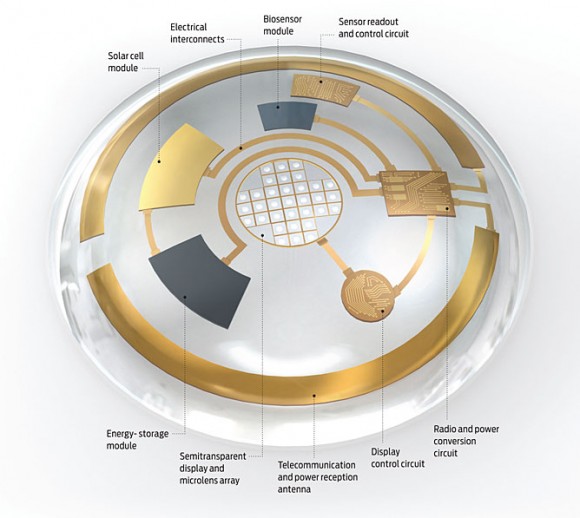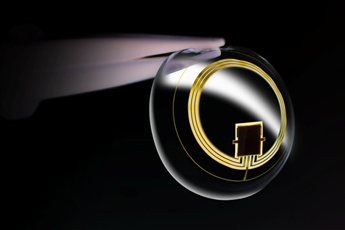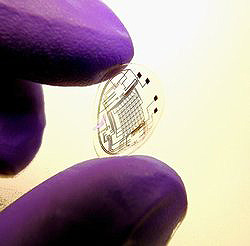It looks like you're using an Ad Blocker.
Please white-list or disable AboveTopSecret.com in your ad-blocking tool.
Thank you.
Some features of ATS will be disabled while you continue to use an ad-blocker.
3
share:
I have done a search for the smart contact lenses but this is all that has come up:
First Steps in Augmented Reality - Google Glasses in NWO forum
This article is from 2011 so old news really but not much info around about it:
I stumbled upon this info while I was looking for information about Contact Lens Displays with Transparent Circuitry.
This one from 2008:
This one is from 2011:
Electronic Contact Lens displays Pixels before the Eyes
Some of those 'abduction stories come to mind', yanno, all the probing and testing. I think some of this technology is scary. Is it possible that guinea pig humans maybe walking around with these kinds of lenses?

This one is recent...April 2013
Microchip Implanted in Eyes of Blind People Helps them to See
This one is from 2010:
Mems putting smart phones into motion

Obviously a good thing for the medical world but could be used for other purposes, yanno, like surveiling the public?
This one is from 2010:
The Future Digital Camera May Not Need A Viewfinder or LCD At All If You Wear These

Future digital camera contact lense
First Steps in Augmented Reality - Google Glasses in NWO forum
This article is from 2011 so old news really but not much info around about it:
Lenses that monitor eye health are on the way, and in-eye 3D image displays are being developed too – welcome to the world of augmented vision
THE next time you gaze deep into someone's eyes, you might be shocked at what you see: tiny circuits ringing their irises, their pupils dancing with pinpricks of light. These smart contact lenses aren't intended to improve vision. Instead, they will monitor blood sugar levels in people with diabetes or look for signs of glaucoma.
The lenses could also map images directly onto the field of view, creating head-up displays for the ultimate augmented reality experience, without wearing glasses or a headset. To produce such lenses, researchers are merging transparent, eye-friendly materials with microelectronics.
Smart contact lenses for health and head-up displays
I stumbled upon this info while I was looking for information about Contact Lens Displays with Transparent Circuitry.
This one from 2008:
Electronic contact lens debuts
"Looking through a completed lens, you would see what the display is generating superimposed on the world outside, but there is much to be done before we have a fully functional display for human use," said EE Babak Parviz, a professor of electrical engineering at the University of Washington. "Our goal [here] was to demonstrate the basic technology, make sure it works and that it's safe."
This one is from 2011:
Electronic Contact Lens displays Pixels before the Eyes
Researchers have created a single-pixel contact lens which was tested on a live rabbit and showed no adverse effect. The in vivo rabbit tested lens contains a display which consists of a 5-millimetre-long antenna, a silicon power harvesting and radio integrated circuit, metal interconnects, insulation layers, and a 750 square micron (one-millionth of a meter) sized transparent sapphire chip containing a custom micro LED.
A tiny illuminated section in the center of the device is activated by a radio transmitter, causing the spot to light up. Unfortunately, while the range of the display was about one meter in free space, that range was reduced to about two centimeters when it was placed on the rabbit’s eye.
Some of those 'abduction stories come to mind', yanno, all the probing and testing. I think some of this technology is scary. Is it possible that guinea pig humans maybe walking around with these kinds of lenses?

This one is recent...April 2013
Microchip Implanted in Eyes of Blind People Helps them to See
A microchip developed by scientists has restored the sight of nine blind people suffering from a degenerative disease after it was inserted into their eyes. The implant, named the Alpha-IMS, is placed under the retina, the inner lining of the eye. The device essentially replaces degenerated light-sensitive rod and cone cells of patients born with the hereditary condition retinitis pigmentosa (RP).
The implant is only about 3 millimeters long by 3 millimeters wide, and less than 100 microns thick, making it thinner than the average diameter of a human hair. Despite its tiny size, the microchip is loaded with 1,500 light detectors, which transmit electrical impulses through a patient’s nerves to generate a colorless 1,500-pixel image. In contrast, other visual implants provide images with significantly less than 100 pixels.
This one is from 2010:
Mems putting smart phones into motion
Tons of products already use MEMS, but it's just the start. Before October, patients will be wearing contact lenses equipped with MEMS to test for glaucoma.

Obviously a good thing for the medical world but could be used for other purposes, yanno, like surveiling the public?
This one is from 2010:
The Future Digital Camera May Not Need A Viewfinder or LCD At All If You Wear These

Imagine wearing contact lenses that allowed you to zoom in on far-off scenes, have useful facts pop into their field of view, or create virtual crosshairs. Researchers at the University of Washington are working on imprinting an electronic circuit and lights at macroscopic scales onto flexible, biologically safe contact lenses that should allow the wearer to see a virtual display.
Future digital camera contact lense
edit on 27-4-2013 by Thurisaz because: insert
Regardless of misuse, it still amazes me how far things have come.
A lot the things I hoped would be created as a child have been created and some of the things being developed blow my mind, not this so much but it is still a great technological breakthrough after another.
A lot the things I hoped would be created as a child have been created and some of the things being developed blow my mind, not this so much but it is still a great technological breakthrough after another.
reply to post by Taggart
yes I laughed when I read the article from 2010 stating 'the future digital camera' and when you consider how quickly technology has advanced, I'd be confident in suggesting that by the year 2013, this R & D would be already achieved.
oh thankyou for the reply
yes I laughed when I read the article from 2010 stating 'the future digital camera' and when you consider how quickly technology has advanced, I'd be confident in suggesting that by the year 2013, this R & D would be already achieved.
oh thankyou for the reply
edit on 28-4-2013 by Thurisaz because: thanks
gee I am surprised that this is not that interesting for others...
I must be the only one paranoid about ending up as an irobot?
I must be the only one paranoid about ending up as an irobot?
reply to post by Dolby_X
I must not be on the same circuitry wavelength cos I just don't relate to what the point is your making.
sorry
I must not be on the same circuitry wavelength cos I just don't relate to what the point is your making.
sorry
new topics
-
Greenland is now calling Trump-let's talk about it
Mainstream News: 11 minutes ago -
Yet another reason for the Civil War... Advancements in steam ships and cannon
History: 30 minutes ago -
Letters to the Editor: Altadena, my neighborhood, has burned. Make fossil-fuel companies pay
Propaganda Mill: 3 hours ago -
The LEGACY of Outgoing President JOSEPH R. BIDEN Jr. - Forced From Office Eff 1.20.2025.
US Political Madness: 3 hours ago -
UK and Europe Floods
Rant: 5 hours ago -
FEMA kicks hurricane survivors out of temporary housing into snowstorm and freezing temperatures
Disaster Conspiracies: 5 hours ago -
Failures of leadership on display
US Political Madness: 6 hours ago -
Power grid faults surged right before Los Angeles wildfires began
Mainstream News: 6 hours ago -
Tustin California Military equipment stolen BIG equipment .
Social Issues and Civil Unrest: 6 hours ago -
PALES-TINE, PALES-ADES and the Australian Aboriginal "Lightning Man"
Dreams & Predictions: 6 hours ago
top topics
-
FEMA kicks hurricane survivors out of temporary housing into snowstorm and freezing temperatures
Disaster Conspiracies: 5 hours ago, 16 flags -
Tustin California Military equipment stolen BIG equipment .
Social Issues and Civil Unrest: 6 hours ago, 15 flags -
Letters to the Editor: Altadena, my neighborhood, has burned. Make fossil-fuel companies pay
Propaganda Mill: 3 hours ago, 15 flags -
Failures of leadership on display
US Political Madness: 6 hours ago, 11 flags -
Power grid faults surged right before Los Angeles wildfires began
Mainstream News: 6 hours ago, 7 flags -
UK and Europe Floods
Rant: 5 hours ago, 6 flags -
The LEGACY of Outgoing President JOSEPH R. BIDEN Jr. - Forced From Office Eff 1.20.2025.
US Political Madness: 3 hours ago, 6 flags -
PALES-TINE, PALES-ADES and the Australian Aboriginal "Lightning Man"
Dreams & Predictions: 6 hours ago, 5 flags -
Yet another reason for the Civil War... Advancements in steam ships and cannon
History: 30 minutes ago, 1 flags -
Greenland is now calling Trump-let's talk about it
Mainstream News: 11 minutes ago, 0 flags
active topics
-
Trump says ownership of Greenland 'is an absolute necessity'
Other Current Events • 214 • : Oldcarpy2 -
Greenland is now calling Trump-let's talk about it
Mainstream News • 0 • : fringeofthefringe -
Letters to the Editor: Altadena, my neighborhood, has burned. Make fossil-fuel companies pay
Propaganda Mill • 8 • : Tolkien -
Failures of leadership on display
US Political Madness • 15 • : network dude -
How To Spot Fake U.F.O. Photos
Aliens and UFOs • 8 • : ArMaP -
Los Angeles brush fires latest: 2 blazes threaten structures, prompt evacuations
Mainstream News • 423 • : xuenchen -
Yet another reason for the Civil War... Advancements in steam ships and cannon
History • 0 • : Solvedit -
The LEGACY of Outgoing President JOSEPH R. BIDEN Jr. - Forced From Office Eff 1.20.2025.
US Political Madness • 8 • : Dalamax -
New UK Petition - Close the borders! Suspend ALL immigration for 5 years!
Regional Politics • 27 • : angelchemuel -
This should be plastered all over the airwaves
Mainstream News • 61 • : fringeofthefringe
3
